
Baltimore is a village in western County Cork, Ireland. It is the main village in the parish of Rathmore and the Islands, the southernmost parish in Ireland. It is the main ferry port to Sherkin Island, Cape Clear Island and the eastern side of Roaring Water Bay and Carbery's Hundred Isles.

West Cork is a tourist region and municipal district in County Cork, Ireland. As a municipal district, West Cork falls within the administrative area of Cork County Council, and includes the towns of Bantry, Castletownbere, Clonakilty, Dunmanway, Schull and Skibbereen, and the 'key villages' of Baltimore, Ballydehob, Courtmacsherry, Drimoleague, Durrus, Glengarriff, Leap, Rosscarbery, Timoleague and Union Hall.

Rosscarbery is a village and census town in County Cork, Ireland. The village is on a shallow estuary, which opens onto Rosscarbery Bay. Rosscarbery is in the Cork South-West constituency, which has three seats.

Timoleague is a village in the eastern division of Carbery East in County Cork, Ireland. It is located along Ireland's southern coast between Kinsale and Clonakilty, on the estuary of the Argideen River. Nearby is the village of Courtmacsherry. It is about 17 km (11 mi) south of Bandon and 48 km (30 mi) from Cork on the R600 coastal road.
Fachtna of Rosscarbery, known also as Fachanan, was the founder of the monastery of Rosscarbery, County Cork. He died around 600.
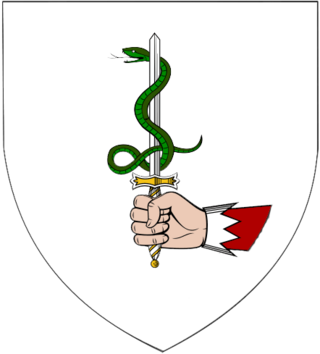
The O'Donovan family is an ancient Irish noble family. Their patronymic surname derives from Irish Ó Donnabháin, meaning the grandsons or descendants of Donnubán, referring to the 10th century ruler of the Uí Fidgenti, Donnubán mac Cathail. During the 12th and 13th century, O'Donovan relations relocated from the Bruree/Croom area south to the Kingdom of Desmond and to Carbery, where they were a ruling family for centuries and played a role in the establishment of a feudal society under the MacCarthys. Other septs retreated into the southeast corner of the Ui Fidgheinte territory, reaching from Broadford/Feenagh to the Doneraile area. The northern septs of the O'Donovans did not use a White Rod as the family's position in their original territory was vastly eroded, while several septs of O'Donovans in the southwest territories were semi-autonomous flatha under the MacCarthy Reagh dynasty in Carbery, with the most notable being local petty kings. The family were counted among the leading Gaelic nobility of Ireland.
The Diocese of Ross was a separate diocese situated in south-west Ireland. Following the Reformation, there were two dioceses. In the Church of Ireland, the diocese is now part of the Diocese of Cork, Cloyne and Ross. In the Roman Catholic Church, it is part of the Diocese of Cork and Ross. In the 19th century, an exclave of the diocese existed around that part of the Beara peninsula in County Cork including the area around Glengariff though not as far east as Bantry. The main diocesan territory was centred on the towns of Baltimore, Skibbereen, Rosscarbery and Clonakilty which lie along the modern national road N71.
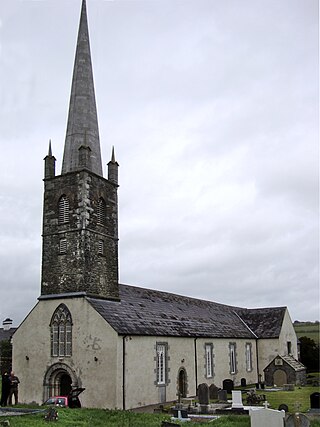
The Bishop of Ross was a separate episcopal title which took its name after the town of Rosscarbery in County Cork, Ireland. The title is now united with other bishoprics. In the Church of Ireland it is held by the Bishop of Cork, Cloyne and Ross, and in the Roman Catholic Church it is held by the Bishop of Cork and Ross.
The Bishop of Cork and Ross is an episcopal title which takes its name after the city of Cork and the County Cork town of Rosscarbery in the Republic of Ireland. The combined title was first used by the Church of Ireland from 1638 to 1660 and again from 1679 to 1835. At present the title is being used by the Roman Catholic Church.
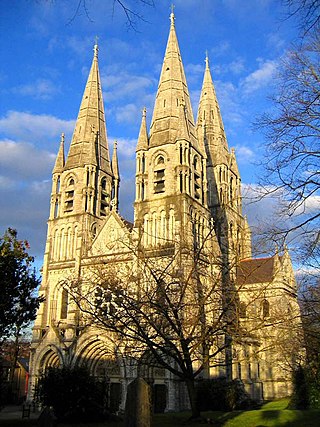
The Diocese of Cork, Cloyne and Ross, also referred to as the United Diocese of Cork, Cloyne and Ross, is a diocese in the Church of Ireland. The diocese is in the ecclesiastical province of Dublin. It is the see of the Bishop of Cork, Cloyne and Ross, the result of a combination of the bishoprics of Cork and Cloyne and Ross in 1583, the separation of Cork and Ross and Cloyne in 1660, and the re-combination of Cork and Ross and Cloyne in 1835.

The Cathedral Church of St. Fachtna, also known as the Cathedral Church of St Faughan,Ross Cathedral, and Rosscarbery Cathedral, is a cathedral of the Church of Ireland in Rosscarbery, County Cork in Ireland. Located in the ecclesiastical province of Dublin, it is the smallest cathedral in Ireland. Having once been the mother church of the Diocese of Ross, it is now one of three Anglican cathedrals in the United Dioceses of Cork, Cloyne and Ross, alongside Saint Fin Barre's Cathedral and Cloyne Cathedral.
The Corcu Loígde, meaning Gens of the Calf Goddess, also called the Síl Lugdach meic Itha, were a kingdom centred in West County Cork who descended from the proto-historical rulers of Munster, the Dáirine, of whom they were the central royal sept. They took their name from Lugaid Loígde "Lugaid of the Calf Goddess", a King of Tara and High King of Ireland, son of the great Dáire Doimthech. A descendant of Lugaid Loígde, and their most famous ancestor, is the legendary Lugaid Mac Con, who is listed in the Old Irish Baile Chuinn Chétchathaig. Closest kin to the Corcu Loígde were the Dál Fiatach princes of the Ulaid.
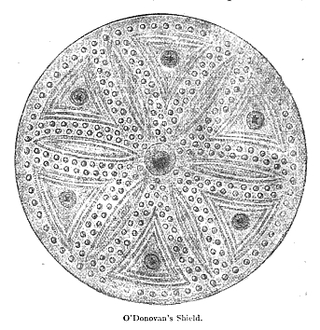
Donal II O'Donovan, The O'Donovan of Clann Cathail, Lord of Clancahill, was the son of Ellen O'Leary, daughter of O'Leary of Carrignacurra, and Donal of the Skins, The O'Donovan of Clann Cathail. He is most commonly referred to as Donnell O'Donevane of Castledonovan in contemporary references of his time.

Carbery, or the Barony of Carbery, was once the largest barony in Ireland, and essentially a small, semi-independent kingdom on the southwestern coast of Munster, in what is now County Cork, from its founding in the 1230s by Donal Gott MacCarthy to its gradual decline in the late 16th and early 17th centuries. His descendants, the MacCarthy Reagh dynasty, were its ruling family. The kingdom officially ended in 1606 when Donal of the Pipes, 17th Prince of Carbery chose to surrender his territories to the Crown of England; but his descendants maintained their position in Carbery until the Cromwellian confiscations, following their participation in the Irish Rebellion of 1641 after which some emigrated to the Chesapeake Colonies.
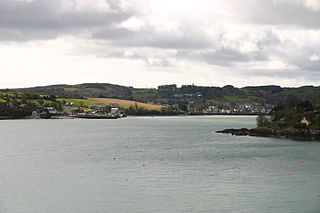
Ímar Ua Donnubáin or Ivor O'Donovan, and possibly nicknamed Gilla Riabach, was a legendary and celebrated petty king, navigator, trader, and reputed necromancer of 13th century Ireland belonging to the O'Donovan family. He may or may not have been the second son of Cathal, son of Crom Ua Donnubáin, from whom the modern Clancahill dynasty descend. In any case Ivor is the ancestor of the historical O'Donovan sept known as the Sliocht Íomhair or "Seed of Ivor", who are generally considered to have been one of the four great septs of the family before being all but destroyed in the 1560s in a conflict with the Clancahill main line. Although mostly legendary, Ivor is possibly referred to in one or two near contemporary sources.
The Dean of Ross is based at the Cathedral Church of St. Fachtna in Rosscarbery in the Diocese of Ross within the united bishopric of Cork, Cloyne and Ross of the Church of Ireland.
Saint Nuadu was the Abbot and Bishop of Armagh, Ireland from 809 to 19 February 812.
Sir Fineen O'Driscoll was an Irish clan chief who was knighted by Queen Elizabeth I. He was more commonly known as The Rover and also known as Fineen of the Ships. He was married to Eileen, daughter of Sir Owen MacCarthy Reagh the 16th Prince of Carbery, whose grandmother Eleanor was a daughter of Gearóid Mór FitzGerald, 8th Earl of Kildare. His eldest son, Connor, was the Lord of Castlehaven. His daughter Eileen married Richard Coppinger, a brother of Sir Walter Coppinger with whom he had numerous disputes over land that continued up to O'Driscoll's death. Another son Fineen was born in 1585. His daughter Mary was captured by a pirate named Ali Krussa and sold into the Barbary slave trade. He also had an illegitimate son, Gilly Duff. Fineen was also brother-in-law to Donal II O'Donovan and the two together with Owen MacCarthy Reagh's family are all noted in collaboration on numerous occasions.
Colla mac Báirid or Colla ua Báirid was a Viking leader who ruled Limerick in the early 10th century. He first appears in contemporary annals in 924 when he is recorded as leading a raiding fleet to Lough Ree. He appears in the annals for the second and final time in 932 when his death his recorded. In both of these instances he is titled king of Limerick. Colla's parentage is uncertain; according to one theory he was the son or grandson of Bárid mac Ímair, a Uí Ímair king of Dublin, and according to another he was the son of Bárid mac Oitir.









